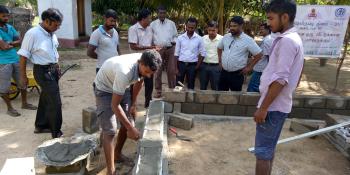
Stronger blocks, more comfortable homes
Stronger and more comfortable: Habitat for Humanity Sri Lanka marks World Habitat Day by sharing knowledge on alternative construction technologies
COLOMBO, 8 November 2017 ─ Habitat for Humanity Sri Lanka marked World Habitat Day with a month-long string of activities to build houses and raise awareness for affordable homes.
“In keeping with the United Nations’ theme for World Habitat Day 2017 of ‘Housing Policies: Affordable Homes’, Habitat for Humanity Sri Lanka conducted events in October to bring attention to the use of alternative construction materials and technologies in constructing sustainable and affordable homes for communities in need across Sri Lanka”, said Dr. Dinesh Kanagaratnam, National Director of Habitat for Humanity Sri Lanka.
Habitat Sri Lanka is implementing a multi-faceted housing project funded by the European Union that aims to construct and repair nearly 2,400 houses in Batticaloa, Kilinochchi and Mullaitivu by 2020. More than 215,000 people will benefit from the project, which bridges the gap between relief, rehabilitation and development. It utilises alternative materials and techniques to improve the strength and comfort qualities of housing.
The housing project promotes the use of locally manufactured earth blocks and construction materials such as Compressed Stabilized Earth Blocks and Earth Concrete Blocks. Additionally, this European Union funded housing project has enabled Habitat for Humanity Sri Lanka to introduce innovative alternative construction materials and technologies such as the Fairface masonry technology, Ferrocement, reinforced mortar and filler slab. Habitat Sri Lanka kicked off its World Habitat Day celebrations in Kilinochchi on October 3 with a program to train more than 30 technical officers and masons of the National Housing Development Authority (NHDA) on the use of the Fairface technology. This masonry technique uses uniformly cast blocks with pointed mortar joints. It is both an eco-friendly and more cost-effective alternative to the regular process of plastering walls because it uses less sand and cement and results in a better finish and improves the look of the house.
In late October, Habitat Sri Lanka conducted a knowledge sharing workshop on Compressed Stabilized Earth Blocks for 126 civil engineering students from the Technical College in Batticaloa. The workshop included a visit to Habitat Sri Lanka’s CSEB production yard and CSEB model house in Villavettuvan, Batticaloa. Students had the opportunity to learn about the block’s strength and eco-friendliness. The CSEB, which is being used to construct Habitat’s European Union-funded housing project, makes houses more comfortable for families because their houses are cooler during the day and warmer in the evening. And building with stronger blocks gives families some reassurance of the sturdiness of their homes.
The United Nations designated World Habitat Day highlights the basic right of every person to adequate shelter. Habitat for Humanity Sri Lanka shares a similar conviction and envisions a Sri Lanka where everyone has a decent, durable place to live in dignity and safety. Operating in Sri Lanka since 1994, Habitat Sri Lanka has supported more than 24,600 families to build and improve places they can call home.
The Compressed Stabilized Earth Blocks, which is being used to construct Habitat’s European Union-funded housing project, makes houses more comfortable for families because their houses are cooler during the day and warmer in the evening. Building with stronger blocks gives families some reassurance of the sturdiness of their homes.